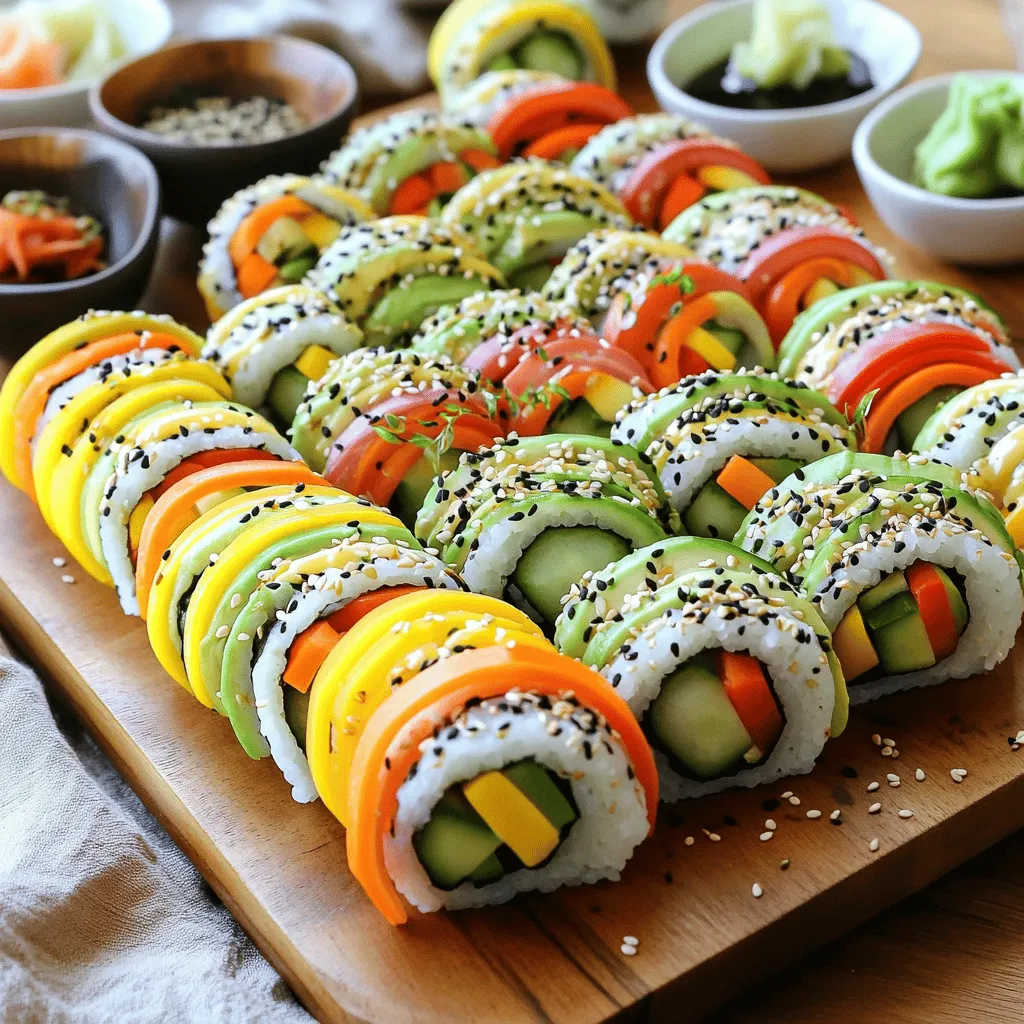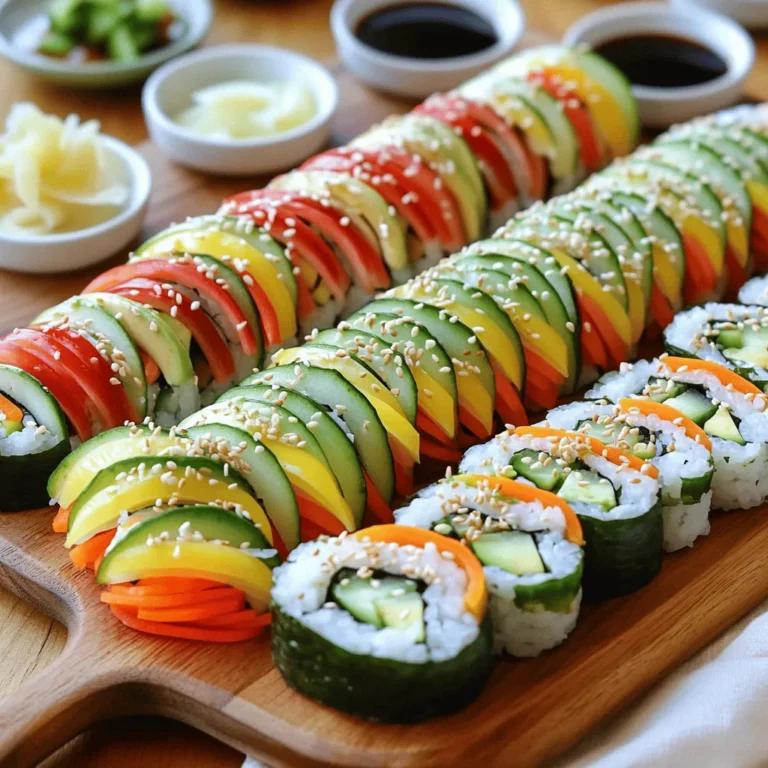Ready to delight your taste buds? This Rainbow Veggie Sushi Rolls recipe is as colorful as it is tasty! With fresh veggies and simple steps, you’ll create a dish that looks great and tastes even better. Whether you’re a sushi pro or a newbie, you’ll find it easy to make at home. Let’s roll up some fun with vibrant flavors and healthy ingredients!
Ingredients
To make Rainbow Veggie Sushi Rolls, you need fresh and colorful ingredients. Here’s what you will need:
– 2 cups sushi rice
– 2 1/2 cups water
– 1/4 cup rice vinegar
– 1 tablespoon sugar
– 1 teaspoon salt
– 4 sheets nori (seaweed)
– 1/2 cucumber, julienned
– 1 large carrot, julienned
– 1/2 red bell pepper, thinly sliced
– 1/2 yellow bell pepper, thinly sliced
– 1 avocado, sliced
– 1/2 cup sprouts (e.g., radish or alfalfa)
– Soy sauce (for dipping)
– Wasabi and pickled ginger (optional)
These ingredients not only add flavor but also create a stunning visual treat. The bright colors make the sushi rolls pop. You can mix and match veggies based on your taste. For example, add some purple cabbage or mango for a twist. This recipe makes it easy to enjoy sushi at home.
Step-by-Step Instructions
Preparing the Sushi Rice
To start, rinse the sushi rice under cold water. You want to rinse until the water runs clear. This step removes excess starch. Too much starch makes the rice gummy. After rinsing, put the rice in a medium saucepan. Add 2 1/2 cups of water. Bring the mixture to a boil. Then, lower the heat to a simmer. Cover the pan and let it cook for about 20 minutes. The rice should be tender, and all the water should be absorbed.
Making the Sushi Vinegar
While the rice cooks, it’s time to make the sushi vinegar. In a small bowl, mix together rice vinegar, sugar, and salt. Stir until the sugar and salt dissolve. You can microwave this mixture for about 30 seconds to help it dissolve faster. This vinegar adds a nice flavor to the rice.
Rolling the Sushi
Now, let’s roll the sushi! First, place a bamboo sushi mat on a clean surface. Take a sheet of nori and lay it shiny side down on the mat. Wet your hands to stop the rice from sticking. Grab about 3/4 cup of sushi rice and spread it evenly over the nori. Leave about an inch at the top edge free of rice. Next, arrange your veggies along the bottom edge. Use cucumber, carrot, bell peppers, and avocado. Top with a small amount of sprouts for crunch.
Starting from the edge closest to you, lift the bamboo mat. Begin rolling away from you. Press gently, but firmly, to keep the roll tight. Keep rolling until you reach the free edge of the nori. Use a little water to seal the edge. With a sharp knife, slice the roll into 6-8 pieces. Wipe the knife with a damp cloth between cuts to keep the edges clean. Repeat with the rest of your ingredients.
Tips & Tricks
Perfecting Your Roll
To make tight sushi rolls, you need a few key techniques. First, wet your hands before handling the rice. This helps prevent sticking. Use about 3/4 cup of rice for each roll. Spread it evenly over the nori, leaving space at the top. When rolling, start from the edge closest to you. Gently lift the bamboo mat and roll away from you. Press firmly but not too hard. You want a tight roll without squishing the filling. Finally, seal the edge with a little water.
Keeping Ingredients Fresh
Fresh veggies make your sushi vibrant and tasty. To keep them fresh, store your veggies in the fridge. Wrap them in a damp paper towel. This keeps moisture in and prevents wilting. Use them within a few days for the best crunch. If you cut your veggies ahead of time, keep them in an airtight container. They will last well for up to two days.
Presentation Ideas
When serving your sushi, presentation matters. Arrange the rolls on a clean platter. Place them cut-side up for a beautiful display. Add small bowls of soy sauce for dipping. If you like, garnish with wasabi and pickled ginger. A sprinkle of sesame seeds on top adds flavor and style. Make your plate colorful and inviting! Get creative with your layout for an extra wow factor.

Variations
Colorful Vegetable Alternatives
You can swap the veggies in your sushi rolls for more colors and flavors. Try using:
– Zucchini, julienned
– Purple cabbage, thinly sliced
– Spinach, fresh leaves
– Radishes, thinly sliced
– Asparagus, blanched
These alternatives add crunch and brightness. You can mix and match to find your favorites.
Flavor Enhancements
To boost flavor, consider adding extra ingredients. Here are some ideas:
– Creamy hummus or avocado spread for a rich taste
– Fresh herbs like basil or cilantro for a fresh kick
– Pickled vegetables for tanginess, like pickled carrots or radishes
– Chili paste for heat, if you like spice
These small additions can change your sushi rolls into a flavor explosion.
Different Sushi Types
You can explore other sushi styles too. Here are some options:
– Temaki (hand rolls) are fun to make. Just wrap the nori around the filling.
– Uramaki (inside-out rolls) flip the rice outside. This gives a unique look.
– Nigiri sushi features rice topped with fish or veggies, easier for beginners.
Trying different types can make your sushi-making journey exciting.
Storage Info
How to Store Sushi Rolls
To keep your sushi rolls fresh, wrap them tightly in plastic wrap. This helps keep the moisture in and prevents them from drying out. Store the wrapped rolls in the fridge. They taste best within 24 hours. If you have leftover sushi rice, store it in an airtight container. Rice is best when used fresh, but you can keep it for a day or two.
Reheating Methods
Sushi rolls are best enjoyed cold, but if you want to reheat them, do it carefully. Use a microwave on low heat for about 10-15 seconds. Check the rolls often to avoid overheating. This method warms them without cooking the fish or veggies. If you have rice leftover, you can reheat it in the microwave with a splash of water.
Freezing Sushi
Can you freeze sushi rolls? Yes, but it is not the best option. Freezing can change the texture of the rice and veggies. If you must freeze them, wrap each roll in plastic wrap, then place them in a freezer bag. They can last up to a month. When you’re ready to eat, thaw them in the fridge overnight.
FAQs
How to make sushi rice less sticky?
To make sushi rice less sticky, rinse it well. Rinse the rice under cold water until the water runs clear. This removes extra starch. You can also soak the rice for 30 minutes before cooking. This helps the rice cook better. Lastly, use the right water-to-rice ratio. A good ratio is 1.25 cups of water for every cup of rice.
Can I use brown rice instead of white rice?
Yes, you can use brown rice. Brown rice is a whole grain and has more fiber. It takes longer to cook, so adjust the time accordingly. Brown rice has a nuttier taste, which can add flavor. Keep in mind, though, that the texture will be different. Sushi made with brown rice may not stick together as well.
What’s the best way to slice sushi rolls?
To slice sushi rolls cleanly, use a sharp knife. Wet the knife before cutting. This helps prevent the rice from sticking. Cut the roll into 6 to 8 pieces. Make smooth, single cuts. Avoid pressing down too hard, as this can squish the roll. For best results, wipe the knife after each cut. This keeps the edges neat and tidy.
We explored the key ingredients and steps needed to make sushi at home. From perfecting sushi rice to choosing fresh veggies, you now have the skills to create delicious rolls. Remember to store your sushi properly and experiment with different flavors. Don’t hesitate to try various ingredients and types. Making sushi can be fun and rewarding. Enjoy your sushi-making journey, and impress your friends and family with your new skills!


